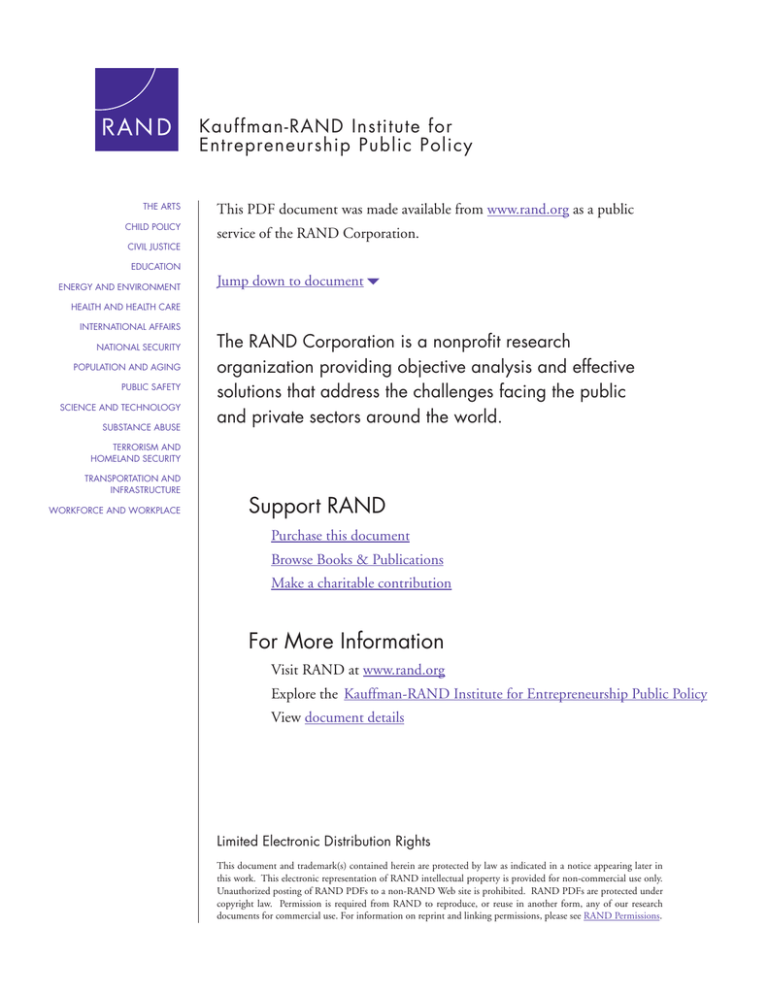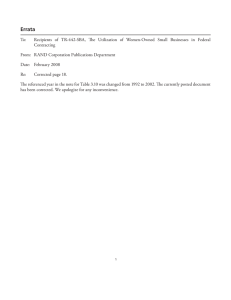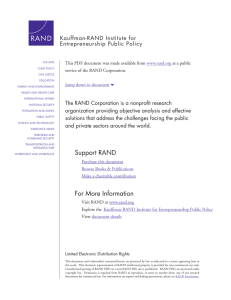
Kauffman-RAND Institute for
Entrepreneurship Public Policy
THE ARTS
CHILD POLICY
CIVIL JUSTICE
EDUCATION
ENERGY AND ENVIRONMENT
This PDF document was made available from www.rand.org as a public
service of the RAND Corporation.
Jump down to document6
HEALTH AND HEALTH CARE
INTERNATIONAL AFFAIRS
NATIONAL SECURITY
POPULATION AND AGING
PUBLIC SAFETY
SCIENCE AND TECHNOLOGY
SUBSTANCE ABUSE
The RAND Corporation is a nonprofit research
organization providing objective analysis and effective
solutions that address the challenges facing the public
and private sectors around the world.
TERRORISM AND
HOMELAND SECURITY
TRANSPORTATION AND
INFRASTRUCTURE
WORKFORCE AND WORKPLACE
Support RAND
Purchase this document
Browse Books & Publications
Make a charitable contribution
For More Information
Visit RAND at www.rand.org
Explore the Kauffman-RAND Institute for Entrepreneurship Public Policy
View document details
Limited Electronic Distribution Rights
This document and trademark(s) contained herein are protected by law as indicated in a notice appearing later in
this work. This electronic representation of RAND intellectual property is provided for non-commercial use only.
Unauthorized posting of RAND PDFs to a non-RAND Web site is prohibited. RAND PDFs are protected under
copyright law. Permission is required from RAND to reproduce, or reuse in another form, any of our research
documents for commercial use. For information on reprint and linking permissions, please see RAND Permissions.
This product is part of the RAND Corporation technical report series. Reports may
include research findings on a specific topic that is limited in scope; present discussions of the methodology employed in research; provide literature reviews, survey
instruments, modeling exercises, guidelines for practitioners and research professionals, and supporting documentation; or deliver preliminary findings. All RAND
reports undergo rigorous peer review to ensure that they meet high standards for research quality and objectivity.
TECHNICAL
R E P O R T
The Utilization of
Women-Owned
Small Businesses in
Federal Contracting
Elaine Reardon, Nancy Nicosia,
Nancy Y. Moore
Prepared for the Small Business Administration
Kauffman-RAND Institute for
Entrepreneurship Public Policy
This study was undertaken in response to a request by the SBA for the RAND Corporation
to provide different measures of WOSB representation in federal contracting, by industry.
The work was funded by the SBA and completed under the auspices of the RAND Labor
and Population program and the Kauffman-RAND Institute for Entrepreneurship Public
Policy.
Library of Congress Cataloging-in-Publication Data
Reardon, Elaine.
The utilization of women-owned small businesses in federal contracting / Elaine Reardon, Nancy Nicosia,
Nancy Moore.
p. cm.
Includes bibliographical references.
ISBN 978-0-8330-4166-1 (pbk. : alk. paper)
1. Public contracts—United States. 2. Women-owned business enterprises—United States.
I. Nicosia, Nancy. II. Moore, Nancy Y., 1947– III. Title.
HD3861.U6R43 2007
352.5'3082—dc22
2007016169
The RAND Corporation is a nonprofit research organization providing objective analysis
and effective solutions that address the challenges facing the public and private sectors
around the world. RAND’s publications do not necessarily reflect the opinions of its
research clients and sponsors.
R® is a registered trademark.
© Copyright 2007 Small Business Administration
All rights reserved. No part of this book may be reproduced in any form by any electronic or
mechanical means (including photocopying, recording, or information storage and retrieval)
without permission in writing from the Small Business Administration.
Published 2007 by the RAND Corporation
1776 Main Street, P.O. Box 2138, Santa Monica, CA 90407-2138
1200 South Hayes Street, Arlington, VA 22202-5050
4570 Fifth Avenue, Suite 600, Pittsburgh, PA 15213-2665
RAND URL: http://www.rand.org
To order RAND documents or to obtain additional information, contact
Distribution Services: Telephone: (310) 451-7002;
Fax: (310) 451-6915; Email: order@rand.org
Summary
In 2000, the Small Business Reauthorization Act (Public Law 106-554, Section 811) authorized contracting officers to restrict competition for federal contracts on a discretionary basis
in certain industries to women-owned small businesses (WOSBs). These industries are determined by the Small Business Administration (SBA) to be characterized by underrepresentation
or substantial underrepresentation of WOSBs in federal prime contracts. Through a series of
legal decisions, especially decisions regarding minority-owned firms, underrepresentation in
government contracting has come to mean that the share of contracts awarded to a particular
type of firm is small relative to the prevalence of such firms in the pool of firms that are “ready,
willing, and able” to perform government contracts.
This measure of underrepresentation is typically referred to as a disparity ratio. A disparity ratio of 1.0 suggests that firms of a particular type are awarded contracts in the same proportion as their representation in the industry—that is, there is no disparity. A disparity ratio
of less than 1.0 suggests that the firms are underrepresented in federal contracting, and a ratio
greater than 1.0 suggests that they are overrepresented.
Measuring Disparity Ratios in Federal Contracting
The SBA asked RAND to compute disparity ratios for WOSBs based on both the dollar
value and the number of contracts awarded to WOSBs. The SBA also requested that RAND
define the population of firms that are ready, willing, and able to perform federal contracts in
two ways: (1) as the population of all firms in the economy and (2) as the population of firms
that have registered as potential bidders for federal contracts. Thus, in this report, we present
disparity ratios computed in four ways: ratios based on number of contracts and on contract
dollars in which the population of ready, willing, and able firms is essentially all firms, and
ratios based on number of contracts and contract dollars in which the population of ready,
willing, and able firms is all firms that have registered as potential bidders for federal contracts.
We also explored whether there was a subset of smaller contract sizes (such as contracts under
$100,000) for which it might make more sense to examine small-business contracting, but we
did not find evidence of such a subset.
In this study, we compute disparity ratios by industry, defined according to the North
American Industry Classification System (NAICS) at the 2-, 3-, and 4-digit levels (corresponding to increasingly disaggregated industry classifications). Following SBA guidelines,
ix
x
The Utilization of Women-Owned Small Businesses in Federal Contracting
we classify WOSBs as underrepresented in industries in which the disparity ratio is between
0.5 and 0.8, and substantially underrepresented in industries in which the disparity ratio is
between 0 and 0.5.
Data
We used three datasets to compute the four types of disparity ratios. The Federal Procurement
Data System (FPDS) contains data on federal prime contracts over a certain size. These data
can be used to compute the value of federal contracts awarded to WOSBs and all other firms.
We use FPDS data from three fiscal years (FYs): FY02, FY03, and FY05. The Central Contractor Registry (CCR) lists the firms that have registered with the federal government in anticipation of bidding on federal contracts. With these data, we computed the number of ready,
willing, and able WOSBs and the number of all ready, willing, and able businesses. Because
the CCR data are not archived, we used the October 2006 file to compare with the most recent
available contracting data in the FY05 FPDS. Finally, we constructed measures of the total
number of employer businesses and women-owned employer businesses in the population,
using the 2002 Survey of Business Owners (SBO), part of the 2002 Economic Census.
We did not make any adjustments to the official NAICS industry groupings; thus, dissimilar industries sometimes fall into the same code. (For example, NAICS code 6115 includes
cosmetology schools as well as flight-training schools.) Finally, only industries with samples
large enough to calculate significant differences across groups were analyzed.
Key Findings
We found that the measurement of whether WOSBs are underrepresented in federal contracting is sensitive to whether contract awards are measured in dollars or in number of awards and
to whether the population of ready, willing, and able firms comprises essentially all employer
firms or just those firms that have registered as potential bidders on federal contracts. Depending on the measure used, underrepresentation of WOSBs in government contracting occurs
either in no industries or in up to 87 percent of industries. The variation is especially large in
the measures that use contract dollars rather than number of contracts. This report does not
advocate a particular measure. Rather, it highlights industries where disparities occur and discusses how the identification of these industries varies depending on the methodology used
and on data limitations.








